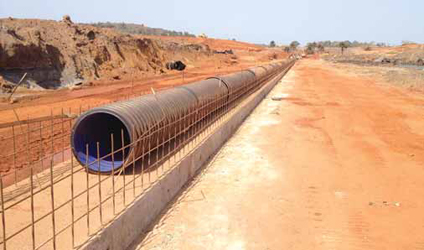
It’s common to find water management strategies at mines that are based on expensive high-pressure
pumped systems when more economical gravity flow would be sufficient in many cases, says U.K.-based
plastic pipe supplier Polypipe.
Gravity Flow vs. Pumped Systems: Are You Overspending on Pipes and Pumps?

By Phillip Wood
While many mining applications rely upon the delivery of high-pressure water requiring powerful pumps and heavy-duty pipework, elements of an effective water management system can often operate successfully without the need for pumps. Tailings management and heap-leach processes can sometimes be configured to use “cost-free” gravity flow, along with general rainwater or storm water drainage management as non-pressurized systems. However, it is common to see pumped-pipe systems specified for such applications, leading to unnecessary expenditure on pumps and high-specification pipes themselves, as well as on the ongoing maintenance of the equipment. Similarly, higher-pressure pipes are frequently specified where there is no benefit in doing so. Fully certified, high-quality, high-density polyethylene (HDPE) pipes designed for gravity-application pressure grade would provide all the required corrosion and abrasion resistance required of mining applications without the added expense of a higher rating.
All pressure pipelines carry a Pressure Nominal (PN) rating, which indicates the pressure (in bars) the pipe can support when the water inside is at 20°C. For all too many gravity applications, PN10 or even PN16 is frequently specified, when in actuality the water or slurry within is drip-fed, meaning a less expensive gravity pipeline will be more than sufficient for the purpose.
Pump manufacturers typically estimate that up to 90% of a pump’s lifetime cost is attributed to energy usage, wear and parts, making them one of the most expensive components on a mine site and even more costly if they are specified when not truly required. Poorly maintained pumps or those work- ing in the harsh conditions typical of mining environment fare even worse, with one leading pump manufacturer estimating that, of the 2,700 pumps they have examined since the 1980s, more than a third were running at less than 40% efficiency. These high operating costs can, in some cases, be avoided by designing a gravity flow solution in preference to a pumped system. Plastic pipe supplier Polypipe can assess a mine’s water management system design to determine if a pumped system is required, and identify areas where gravity flow is appropriate.
In designing an efficient and safe tailings management facility, for example, establishing a stable water balance will prevent future problems such as overflow. This can be achieved by taking into account not only the daily inflow and outflow expected of the facility, but also allowing for storm surges. Using a series of gravity pipes to drain into the tailings pond itself can help maintain a manageable, steady flow, while at the other end of the system, gravity pipes can be used to decant water from the dam walls to water treatment facilities.
Heap leaching converts the desired minerals into a chemical compound, which, at the bottom of the leach pile, drains into perforated pipe and is carried by gravity to the final extraction process, usually via a pregnant solution pond. With no pumping required, heap leaching is gaining in popularity—offering a minimal level of capital expenditure compared with other more intensive methods— though it does require a greater time investment over other methods such as tank leaching.
Bypassing pumped systems at the recovery and wastewater stages can provide tangible cost benefits, but must be carefully planned to ensure the chosen pipes perform at their optimum level. At the specification stage, the American Water Works Association (AWWA) offers the following guidance in its Standard for PE Pressure Pipe and Fittings (1990): “The working pressure of the system plus recurrent surge pressure associated with a specific piping arrangement or operation should not exceed 150% of the pipe pressure rating.”

Regardless of the PN rating, all HDPE pipes possess the key characteristics that make them suitable for mining applications. Highly resistant to abrasion from both minerals and substrate carried in slurry, they are also resistant to many of the chemicals commonly used in mining and mineral extraction, including acetatic acid, ammonium hydroxide, hydrogen peroxide and calcium hydroxide.
Utilizing a gravity flow system will not only deliver cost savings in terms of avoiding expensive pumps, ongoing maintenance and high-pressure pipes; HDPE pipes are lighter than traditional materials and are therefore cheaper, easier and safer to transport and install. They can be supplied in longer lengths than more expensive concrete or ductile iron solutions, meaning fewer joints are needed, which further reduces the possibility of leakage. Ideally suited to harsh operating environments, HDPE water management solutions can withstand temperatures in the range of -40°C to +60°C.
Polypipe’s PE100 solution is an effective intermediate pipe solution with all the benefits of PE, capable of handling up to 25 bars (~350 psi) of pressure depending on the temperature. Ridgidrain, meanwhile, is an HDPE twin-wall pipe solution for non-pressurized drainage applications, which is up to 94% lighter than concrete and features a structured wall design for high ring stiffness and strength. For additional storm surge water storage, Polystorm is a crate-based, modular water storage system, which can be integrated with either PE100 or Ridgidrain to provide emergency storage for excessive rainwater or for attenuation and soakaway systems.
Correct specification of pipes for mining applications can help save money in several ways; from the initial purchase cost, to the added expense of running an unnecessary pump system when gravity could be exploited within tailings management and heap-leach applications amongst others. Working closely with a water management specialist such as Polypipe can help optimize a mine’s pipeline design without compromising on quality of materials. When a pipeline points downhill, Polypipe’s recommendation is to use the power of gravity—it is as free as the air we breathe.
Phillip Wood is international business development
manager at Polypipe.
For further
information, visit www.polypipe.com/mining.